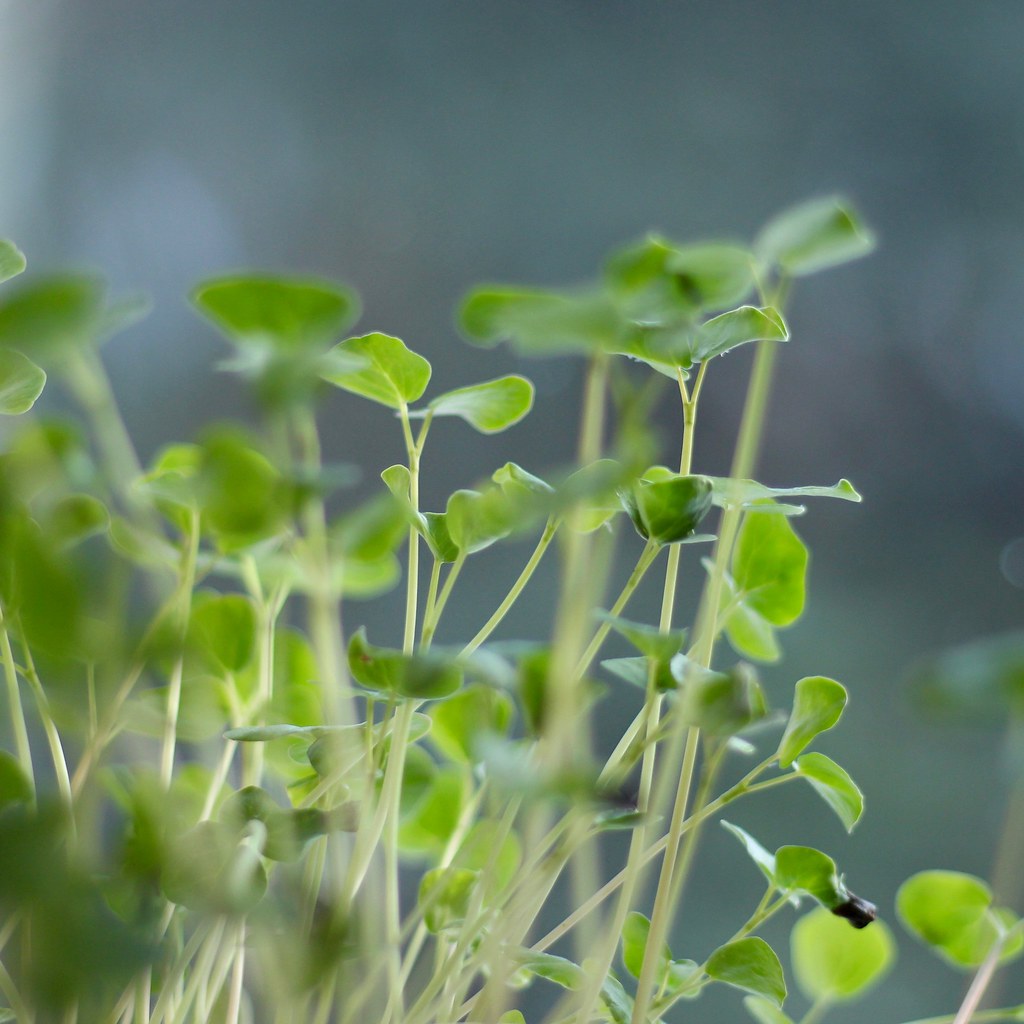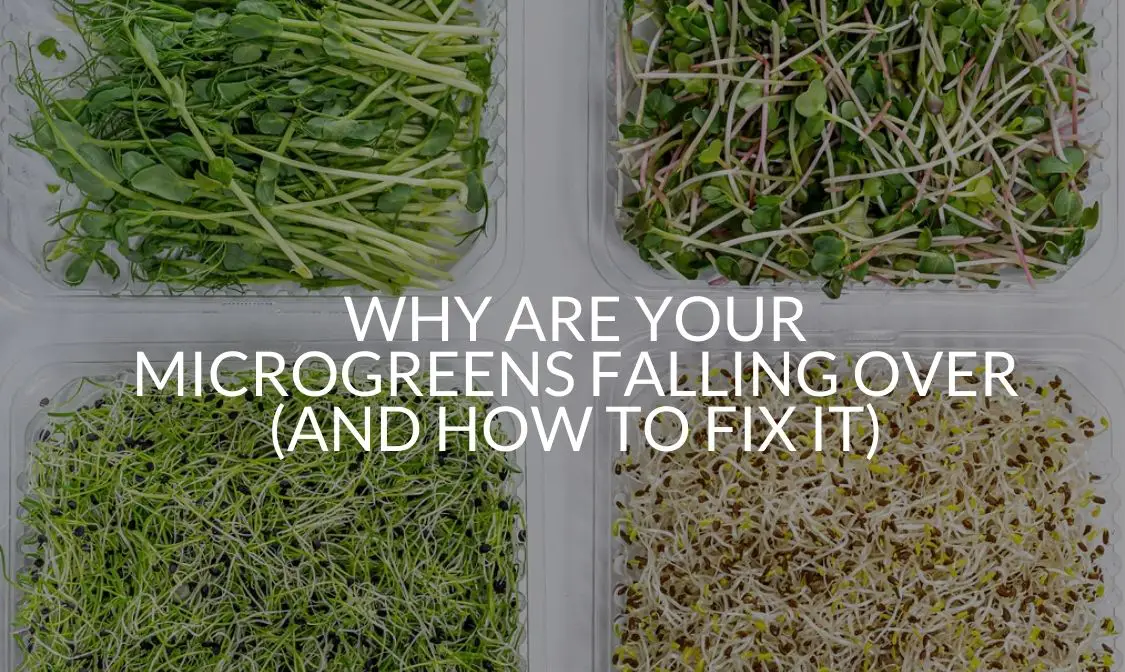If you grow any sort of microgreen at home, you know how fulfilling and satisfying it can be to have fresh food greens on your windowsill or kitchen counter.
However, if you are finding that your microgreens are falling over rather than standing up straight, you may not be caring for them properly.
If your microgreens are falling over, there are some easy solutions to make sure that they grow up tall instead of being a wilted mess of limp greens.
Some reason that microgreens may be falling over is:
- A lack of water
- Too much water
- Too many seeds in the tray
- Watering your greens from the top
- Not enough light
- Too high of a temperature or incorrect humidity levels
Why Are My Microgreens Falling Over Instead Of Growing Tall?
Here is a more in-depth explanation behind why your microgreens are falling over! As well as more importantly, how to fix it!
Reason #1: A Lack of Water
If your microgreens are not receiving adequate water, they may wilt and fall over. You can see this happening with just about any plant, so it is important to ensure that you are maintaining a proper watering scheduling for your plant.
The reason that plants start to wilt when they are lacking water is due to something called turgor. Basically, turgor has to do with the fluid in a cell, which presses the cell wall against the cell membrane.
When the cells are filled with adequate fluid, the plant can maintain its rigid shape, and the stalks and stems of plants can stand upright.
When there is not adequate fluid in the cells, from lack of watering, the cell does not contain enough fluid, and the plant cannot maintain its rigid shape.
To put the scientific explanation lightly, if your microgreens are looking a little sad and wilted, and you notice that the soil is dry, your first step should be to water the greens.
If the microgreens are just suffering from a lack of water, they should pop back up rather quickly after being watered.
Reason #2: Too Much Water
While a lack of water is an issue for microgreens, too much water can also be a problem.
When plants are overwatered, their roots can become overly saturated and can become rotten.
When the soil is too wet, the roots will not be able to get adequate oxygen and this can lead to the microgreens getting diseases. This in turn will definitely cause your microgreens to fall over.
To alleviate over (or under) watering your microgreens, be sure to check the soil before you water it. If the soil is bone dry, it definitely needs water.
If you are about to water your greens and you notice that the soil is already damp, you can skip watering for the moment. You can always check back later in the day to see if the plant has dried out and requires water.
Another great way to ensure that your plants are not overwatered is to use trays or growing pots with drainage holes. This will help to ensure that any excess water is allowed to drain through the soil and will prevent your greens from being overwatered and sitting in a puddle where they are sure to rot.
Reason #3: Too Many Seeds in the Tray
Microgreens are generally grown in a small pot or tray, and the seeds are densely packed. This is what leads to microgreens looking like a little box of tightly packed shoots or grass.
However, if there are too many seeds in the tray and the tray is too tightly packed, the microgreens may not get enough air circulation.
Lack of air circulation in the tray can lead to mold growth, which can in turn lead to your microgreens falling over.
It may be tricky to know how densely to plant your microgreen seeds. For the most part this knowledge will come from trial and error, but it may be worth it to have a look at this link which talks about seeding density, and mentions that on average about 21 seeds per square inch of soil is an adequate density.

Reason #4: Watering Microgreens From the Top
Before the seeds germinate, watering from the top is okay. But watering your microgreens from the top can cause them to fall over because the water pressure may be too harsh for their delicate stems.
Once your microgreens have started to sprout, it is important to begin watering them from the bottom. You can do this by placing a second tray (without holes) under your main tray, putting some water in the second tray. The roots and soil will take as much water as they need.
Alternatively, you can add water right to the soil, just taking care to water at the base of the greens, rather than over top.
Reason #5: Not Enough Light
Like all plants, if microgreens are not exposed to enough light they will not be able to photosynthesize. When this is the case, they will start to wilt and fall over.
Once microgreens have sprouted, they require about 4-6 hours of sunlight a day. If you have a sunny spot in your home, this should not be an issue. Just leave them by a west-facing window and that should do the trick.
However, if you live in a home or perhaps a basement apartment without much natural light, it may be worth it to buy a grow light. That way you can control exactly how much light the plant gets. You can purchase grow lights from Amazon, or through a local garden supply store.
Reason #6: Incorrect Temperature or Humidity
All plants require specific parameters in terms of temperature and humidity. While microgreens generally thrive in warm, moist conditions, they will start to fail and wilt if they get too hot.
The average home will not be too warm for microgreens but if you are using grow lights and your greens are wilting and falling over, you may need to make sure that your grow lights are not too close to the top of the plants.
Make sure that your grow lights are at least 12 inches taller than the tops of your microgreens, to avoid burning or overheating them.
In the case of humidity, microgreens prefer to have about 40-50% humidity to grow properly. If your home gets very dry in the winter, you may want to try turning on a humidifier for a little while each day. This will not only benefit your microgreens but also yourself – especially if you suffer from dry skin or nosebleeds in the winter.
Microgreens are a great choice to grow at home if you enjoy having something fresh to add to salads, sandwiches, and other dishes.
These greens can be grown in a really small space, so they make a perfect choice for people who want to enjoy the benefits of gardening and growing their own food, but may live in a small apartment or just not have much space.
They can be really fun to grow if you have kids, as they grow fairly quickly, and kids can see almost instant results as they grow.
As long as you ensure that you follow the steps listed above, your greens are sure to grow tall and healthy, and not fall over and wilt!
Recap
As you can see, there are a number of reasons that your microgreens may be falling over, but even better there are also a whole bunch of ways you can stop this from happening! Follow the advice above and watch your microgreens grow healthy and strong!




